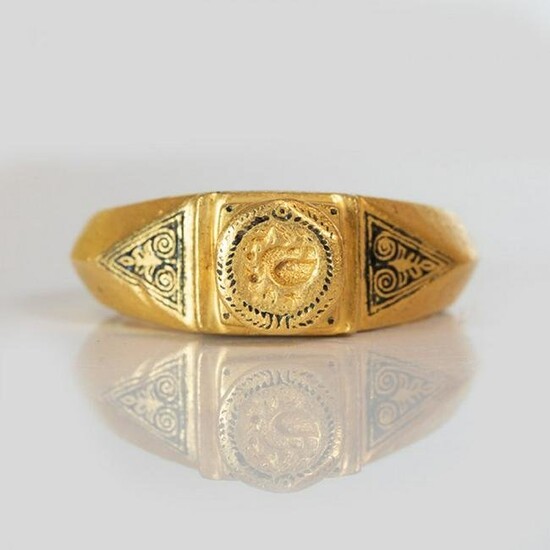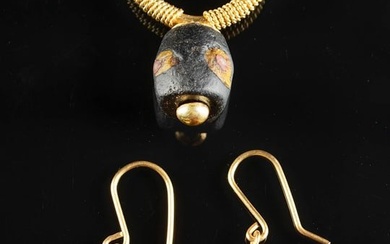Ring; Byzantine culture, 6th-7th centuries. Gold and
Ring; Byzantine culture, 6th-7th century.
Gold and ice.
Publications: Christie's Antiquities, New York 18 December 1998.
Measurements: 26 mm (outer diameter); 19 mm (inner diameter).
Weight: 26.78 gr.
Byzantine ring made in gold, presenting a solid cast with a smooth rim, of semicircular section with flattened sides, expanding to triangular shoulders, with a pyramidal bezel with two steps topped by an inverted cone trunk engraved on the circular face with a line in profile to the right, a lizard to its right, a crescent moon and a star above, enclosed within a crown, extensive niello inlay including scrolls on the flattened sides, scrolls on a palmette on the shoulders, a key and zig-zag pattern on the sides of the pyramidal steps, and an inscription on each side reading MAPIAC and EYTI HIOV, 'of Mary' and 'of Eutycheios!"The two names in the genitive case suggest that this is a wedding ring and therefore the guinea fowl engraved on the bezel is likely to represent the favourite dish of a wedding feast.
The Byzantine Empire, the cultural heir to the Roman Empire as it was formed from its eastern part, maintained and expanded many of the techniques of antiquity in its art, including jewellery, which was enriched with new forms and techniques, as well as maintaining some forms of its tradition. Thus, among the great variety of materials used, gold stood out, with good workshops and craftsmen, with a great variety of forms and decorations.
Estimate
Time, Location
Auction House
Ring; Byzantine culture, 6th-7th century.
Gold and ice.
Publications: Christie's Antiquities, New York 18 December 1998.
Measurements: 26 mm (outer diameter); 19 mm (inner diameter).
Weight: 26.78 gr.
Byzantine ring made in gold, presenting a solid cast with a smooth rim, of semicircular section with flattened sides, expanding to triangular shoulders, with a pyramidal bezel with two steps topped by an inverted cone trunk engraved on the circular face with a line in profile to the right, a lizard to its right, a crescent moon and a star above, enclosed within a crown, extensive niello inlay including scrolls on the flattened sides, scrolls on a palmette on the shoulders, a key and zig-zag pattern on the sides of the pyramidal steps, and an inscription on each side reading MAPIAC and EYTI HIOV, 'of Mary' and 'of Eutycheios!"The two names in the genitive case suggest that this is a wedding ring and therefore the guinea fowl engraved on the bezel is likely to represent the favourite dish of a wedding feast.
The Byzantine Empire, the cultural heir to the Roman Empire as it was formed from its eastern part, maintained and expanded many of the techniques of antiquity in its art, including jewellery, which was enriched with new forms and techniques, as well as maintaining some forms of its tradition. Thus, among the great variety of materials used, gold stood out, with good workshops and craftsmen, with a great variety of forms and decorations.




